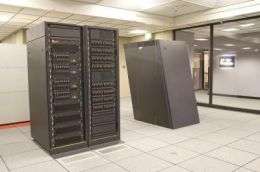NCAR adds resources to TeraGrid

Researchers who use the TeraGrid, the nation’s most comprehensive and advanced infrastructure for open scientific research, can now leverage the computing resources of a powerful, 2048-processor BlueGene/L system at the National Center for Atmospheric Research (NCAR).
NCAR plans to provide up to 4.5 million processor-hours of BlueGene/L computing annually to researchers who have received computing grants from the National Science Foundation (NSF).
The operational integration of TeraGrid with the BlueGene/L system, nicknamed “frost,” involved extensive preparation by NCAR’s Computational and Information Systems Laboratory (CISL). Engineers deployed the necessary networking infrastructure, then established connectivity to NCAR’s data storage systems, and merged the local resource accounting system with the TeraGrid.
“We are excited to be at a point where all our hard work and preparation pays off, and to provide the TeraGrid community with access to this valuable collaborative resource,” says Richard Loft, NCAR TeraGrid principal investigator.
NCAR is also testing experimental systems and services on the TeraGrid. These include the wide-area versions of general parallel file systems from IBM and cluster file systems, as well as a remote data visualization capability based on the VAPOR tool, an open source application developed by NCAR, the University of California, Davis, and Ohio State University under the sponsorship of NSF (see On the Web, below).
NCAR’s frost system, which is operated in partnership with the University of Colorado, will be the second BlueGene/L system on the TeraGrid, joining the San Diego Supercomputer Center’s 6,144 processor system. With the addition of frost, the TeraGrid has more than 250 teraflops of computing capability and more than 30 petabytes of online and archival data storage, with rapid access and retrieval over high-performance networks.
Source: National Center for Atmospheric Research





















